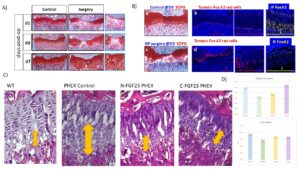Here’s the grant Cartilage progenitor cells for growth plate regeneration
“Growth plate (GP) injuries result in growth arrest, formation of a “bony bar”{a technique that gets rid of the bony bar could potentially be used to make a new growth plate in adults} and angular limb deformities in children. Novel therapeutic approaches directed towards prevention of bone formation and growth arrest have to integrate cellular grafts, biomaterials and growth factors with the ultimate goal of recapitulating the complex zonal organization of the growth plate. One endogenous source of cartilage progenitor cells is thought to be the resting zone of the growth plate. Until now, the lack of specific marker(s) for the resting zone restricted the examination of this population. Currently, the evaluation of potential strategies for growth and cartilage disorders can mainly be achieved in vivo, therefore we proposed to use genetic modified mice to characterize the GP population and to characterize its development. Mice are the most appropriate model to use for several reasons: 1) GP is a tissue hardly approachable in vitro 2) we aim to characterize the GP population, and GP dynamics during the process of growing for which there is no optimal in vitro assays 3) we chose PHEX hemizygous mice for the study of GP dynamics because it is a well stablished model of X-linked hypophosphatemia (XLH){also called vitamin D resistant rickets}, which has being used for decades to study growth plate ossification. An other thing to keep in mind is that the standard treatments for XLH patients do not completely rescue the rickets and bone deformities. Serious side effects such as nephrocalcinosis and hyperparathyroidism have also been observed. Antagonizing FGF23 activity with antibodyes (Burosumab treatment){here’s some papers that indicate that FGF23 inhibition may potentially be part of a growth plate reactivation treatment. FGF23 impacts bone mineralization so that may be why FGF23 inhibition could potentially help with growth plate restoration } is a recent and very promising therapy. However, this treatment requires at least a monthly infusion, is very costly and alleviates symptoms in many patients but not all. Hence, it is of the utmost necessity to identify more affordable strategies for therapy. Dr. Santos’ Laboratory demonstrated that inhibiting the MAPK pathway (FGF23 downstream pathway) in PHEX mice partially rescues growth impairment by normalizing the GP structure, specifically in the hypertropy zone. Nevertheless, it is not completely understood how FGF23 inhibition affects GP dynamics or how this is translated into a growth rescue and whether this treatment would be suitable for paediatric patients. Consequently, we will utilize the PHEX mice and FGF23 to 1) gain a better understanding of GP development and 2) look for alternative therapies to antagonize FGF23 activity.”
“FoxA2+ cells exhibit high clonogenicity and longevity. Moreover, FoxA2+ cell number expand in response to trauma and the data suggest that these cells participate in the production of hyaline cartilage, allowing for successful cartilage regeneration”
“Unlike other cartilage regions such as articular cartilage, GP has the ability to regenerate.”
Since Wild Type was the longest we don’t know it this treatment would have any impact in healthy developing individuals.

